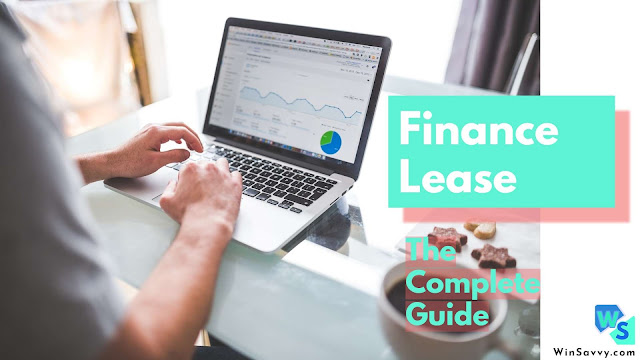A finance lease, also known as a capital lease or sales lease, is a sort of commercial lease in which the legal owner of an asset is a finance firm, and the user leases the property or equipment for an agreed time period. The renting firm, usually a finance company, is referred to as the lessor in this legal contract, while the person who uses the asset is referred to as the lessee.
When a lessee signs this agreement, they gain operational control of the asset. They accept liability for all risks and benefits involved with asset ownership although it is just a lease. The lease gives the lessee with the economic characteristics of asset ownership for accounting purposes.
The item will be recorded as a fixed asset in the lessee’s general ledger. In this case, the lessee will report the lease payment’s interest as an expenditure.
Finance Lease under US GAAP
The agreement must fulfill at least one of the following characteristics to be classified as a financing lease under US GAAP:
- The present value of all the rental payments of the finance lease is equal to or greater than the asset’s fair market value, that is 90% of the original cost of the asset.
- The lease period exceeds 75% of the usable life of the leased asset.
- The lessee is given the opportunity to buy the leased property at a reduced price than that of the fair value of the asset that was leased.
- There will be no original use for the asset to the lessor after the end of the period of the finance lease.
- At the end of the lease financing, the lessor relinquishes legal title of the leased asset and the ownership is transferred to the lessee.
Finance Lease under IFRS
The main standard in more than 100 countries that regulate accounting employing International Financial Reporting Standards is IFRS 16, “Leases,” which a business must use for annual reporting periods commencing on or after January 1, 2019. The old test for lessees was phased out under IFRS 16.
A lease is categorised as a finance lease in an IFRS jurisdiction if all of the following fundamental requirements are met:
- At the end of the lease term, the lessee acquires ownership of the underlying asset;
- the lessee has to be given the option to buy the asset that was under lease financing at a much reduced price compared to the fair value of the leased asset at the date the lessee can exercise the option.
- Further when contracting a finance lease, there has to be reasonable certainty, at the beginning of the contract, that the option of the finance lease will be exercised;
- Even if ownership of the financed asset is not assigned, it has to be ensured that the lease financing term is for the majority of the underlying asset’s useful life;
- At the date of the beginning of the contract, the present value of the payments under the finance lease is at least equal to all of the underlying asset’s fair value or it can be more (usually it is more); and finally –
- The leased asset is of such a nature that it can be used by only the lessee without major modifications. This means that the lessor can not lease it out to anybody else.
Finance Lease under Indian Law
In India too, a finance lease can not be cancelled. However it is unique that the lessor has the option to provide for, in the contract whether it will or will not bear the cost of repair, maintenance and / or insurance of the asset that has been leased to the lessee.
However more often than not, the agreement provides for the lessee to bear the cost of these factors. Also, the option as to the ownership of the asset after the end of the lease period is to be decided in the agreement.
If the agreement provides for the transfer of ownership of the asset at the end of the lease period, it is usually done at a token amount that is the last lease payment or a highly reduced sum of money.
How a Finance Lease Works
Most finance lease agreements follow some pre-defined patterns or steps, which we have listed below –
- If you are a lessee, that is a customer or borrower, you will go to a finance company and ask them to finance you an asset. This is known as the selection phase, wherein you select the asset that you want.
- The lessor, that is the finance company will purchase the asset for you and lease it to you.
- You, the lessee will make use of that asset for your business during the lease. In most cases, the lease lasts for at least 75% of the usable life of the property and this is even mandated by the US GAAP.
- Throughout the rental period, you will pay periodic rentals for the asset use.
- As a cumulative sum, at the end of the lease period, the total amount paid for the lease financing will amount to a large part of or the total of the cost of the asset. It may even be for a value more than the cost of the asset.
- You, the lessee will have the option to buy the asset at the end of the lease period by a token amount (such as paying the last rental or a small additional purchase price).
Impact of Lease Financing on the Business’ Accounting
As per most accounting rules, a financing lease is capitalised and therefore both assets and liabilities increase on the balance sheet. As a result, working capital remains constant, but the ratio of debt to equity rises, producing more leverage.
Finance lease expenses are distributed between interest payments and principal value in the same way that a bond or loan is.
In a cash flow statement, part of the lease payments are shown under operating cash flow and part is recorded under financing cash flow. As a result, operating cash flow rises when accounting for a finance lease agreement.
Lease liabilities are not recognised under operating lease parameters, hence leverage ratios are understated and return ratios (ROE and ROA) are inflated.
A key point to be noted under IFRS accounting principles, IFRS recognizes the applicability of finance lease accounting principles under IFRS 16 to lease financing agreements only if the lessee receives “substantially all the risks and rewards” of ownership from the lessor in the finance lease. Otherwise, it is considered as an operating lease.
Essential Components of a Finance Lease
Since a finance lease agreement is just like a normal agreement, the essentials applicable to other agreements must apply here too – for example, you shouldn’t miss out on creating a section on-
- definitions;
- preamble;
- recitals;
- title of the agreement;
- names of the parties;
- covenants;
- representations;
- warranties;
- payment terms;
- length of the contract and grounds on which the contract can be unilaterally terminated and grounds on which the contract shall be terminated automatically;
- insurance and indemnification;
- power of attorney clause (if any);
- intellectual property clause;
- boilerplate provisions; and
- a clause detailing the applicable statutes of limitations to the contract.
Apart from these, the special provisions that you must ensure are in your finance lease agreement are –
- accurate details of the asset that is to be leased, which includes the model number, the cost price, premium paid if any, usable life of the asset etc.;
- interest rate of the lease;
- schedule for the payment of the principle amount as well as the interest payments;
- penalties and fees for violation of provisions of the contract such as late payments etc.
Since a finance lease document is quite complicated and can differ from state to state as well as the country of the lessee and lessor, it is important that you talk to a legal professional for drafting of your contract.
We, at WinSavvy, offer contract drafting and consultation services, so book a meeting if you need any help.
Finance Lease vs. Operating Lease – What’s the Difference
An operating lease gives you access to equipment while your provider retains ownership. You make regular payments in return for using the item. However, at the end of the contract you don’t get to keep it – although you may be able to renew your contract or buy it outright.
The main difference between a finance lease and an operating lease is that the lessee will recognize a finance lease as an asset on its balance sheet. With an operating lease, however, the lessee will not recognize the asset on its balance sheet.
In a finance lease arrangement, the lessor is considered to be the owner of the leased asset, even though it is in possession of the lessee. The lessor also retains all risks associated with ownership of the asset — for example, if it were to be damaged or stolen during the lease period. The lessee does not have any of these risks, but it does have many of the responsibilities associated with owning an asset.
The lessee recognizes both a liability and an asset on its balance sheet under a finance lease agreement. It will record a liability showing how much it owes to the lessor for leasing the asset and simultaneously record an asset representing its right to use and control the leased asset. The value of this right to use and control is known as its “useful life.”
Operating lease can be more attractive than finance leases, especially for small business owners who need flexible equipment financing solutions and want to keep their operational costs low.
Related Reads:
Different Types of Finance Leases
To be very particular, there isn’t any type of finance lease, but there are forms of finance leases.
They are –
#1. Sale and Leaseback of Asset
This is a case where the lessee is also the vendor of an asset. The lessee sells the asset to another business, which may be the lessor in the case, and then leases the asset back.
So, what’s the reasoning behind this form of transaction?
Well, this happens when the firm may have bought too much of assets and causes itself a working capital problem.
Issue is, that they still need the asset? So, the best way out is to sell the asset, and use the inflow of cash to tide over the working capital problem while at the same time take lease of the asset so as to use it.
Of course, the buyer who is the lessor in this case, considers this transaction to be an investment which has a better Net Present Value when compared to other investments that it could make at the time.
More often than not, banks and financial organizations are the ones who enter into such transactions.
#2. Direct Lease of the Asset
This is the most common form of lease financing agreements, wherein the lessor buys the asset chosen by the lessee and leases it out to the lessee.
The lessor if often a financing company. However, at times it may happen that the lessor is the manufacturing company itself. Usually the manufacturing company partakes in finance lease transactions when there is a dip in the demand compared to the supply.
#3. Leveraged Lease
This is a case wherein the lessor borrows money from a third-party to buy an asset and leases it to the lessee. However, the changed scenario in this case is that often the leased asset is mortgaged by the third party from whom funds have been raised in the first place.
Usually this form of finance lease agreement is a tripartite agreement wherein the lessee pays off the loan via the lease rentals to the fund-lender and then pays the excess amount to the lessor. In these forms of agreements, the lessor is not a financing company but may be an investing company in the lessee’s business.
#4. Modified Lease
A finance lease is characterized by being an agreement which can not be cancelled by the lessee. The leased asset is considered to be a capital asset owned by the lessee and is represented as such in its accounting statements.
As such, there are several restrictions when dealing with a finance lease.
However, a modified finance lease agreement allows the lessee options such as being able to terminate the lease, or purchasing the agreement before the end of the lease period etc.
Advantages of a Finance Lease
The advantages of a finance lease agreement include:
1. Low initial outlay
One of the main advantages of a finance lease agreement is that it allows you to save cash for other business uses. This is because only a small deposit/initial payment and VAT is needed up front.
2. Predictable payments
A finance lease agreement will have fixed payments over an agreed period, so you can budget effectively. You can also choose to make regular or annual payments, depending on your business’s cash flow.
3. Tax relief
Your monthly payments are treated as tax-deductible expenses, which will reduce your tax bill at the end of the financial year.
Further you can claim depreciation on the asset that is under lease financing. This helps reduce your tax liability.
4. Flexibility
At the end of the contract term, you have several options – return the equipment to the leasing company, negotiate a new lease, continue using the equipment and pay a nominal fee or buy it outright for the remainder of its fair market value (a pre-agreed price that is vastly reduced and may even be nominal).
Disadvantages of a Finance Lease
Here are some of the disadvantages of a finance lease agreement:
1. You do not have to pay any down payment or deposit. However, you will have to pay a document fee and sales tax.
2. In case of usage of asset, you cannot change the agreement terms.
For example, suppose you have finance leased a car. Now, you can not change the agreed-upon number of miles that you have stated in the agreement to drive each year, which means there is a chance that you may have to pay extra fees if your miles exceed the stated limit.
Also, you cannot sell, give away or trade in the car before the end of your lease term.
The leased asset is not an asset of the lessee even though it appears on their balance sheet. It is just a “right to use” and that right can be taken away at any time.
3. A finance lease agreement may have to be renewed in every set number of years. Usually it is every three years. This means that you will have to go through all of the paperwork again.
4. If you decide to buy out your lease agreement at the end of its term, then you will have to pay an additional amount for it. The amount depends on how many months are left in your contract. For example, if you have three months left on a 24-month contract and decide to buy out your lease agreement at the end of its term, then you will have to pay an additional amount for it.
This amount is non-refundable even if you cancel your contract before its term ends. The lessee must pay the lease in full regardless of whether they have used or benefited from the asset.
5. You cannot terminate your finance lease agreement before its term ends unless there is a material problem with the asset provided by the leasing company, that vitiates the agreement in its totality.
6. If an item of plant or machinery was leased for three years and then sold for $20,000, there would only be a gain of $20,000 on disposal – there would be no write off for depreciation as this is not applicable as far as the lessee is concerned in this agreement type.
Examples of Finance Lease Uses
Finance leases are often used by large businesses for assets that cost quite a lot. Most businesses do not want to provide downpayment for such extremely large assets as that can cause quite a lot of strain on the working capital of the business concerned.
This reasoning holds even more strongly for startups and small businesses.
Assets such as factory land, abandoned factories, extremely costly machinery, patent usage rights, ships and airplanes are some of the chief use cases of finance leases.
Format of Finance Lease Agreements
If you are trying to draft a finance lease yourself, you need to know that at times, a finance lease transaction is incorporated as a clause of a seperate agreement – for example, a loan-sale agreement.
Further, diverging laws in different countries, states in countries as well as accounting policies make it almost impossible to provide for a standard finance lease agreement.
But, we have collected a collection of sample clauses and agreements providing for finance lease transactions that you can follow for your own agreement.

Wrapping Up on the Financing Lease
Well, that’s all about finance lease agreements. However, do note that the law is not the same in every region. Therefore, this is not legal advice.
If you have a financing lease you want to make, and want to discuss the potential considerations, drawbacks and agreement issues, feel free to send us an email and we’ll guide you through every step of the way!
Finally, if you have any questions, feel free to drop it in the comments and we’ll get back to you!
Read Next:
- How to Register Copyright in the US
- SubLeases: What they Are, How they Work and How to Draft Them
- An International Guide to a Share Purchase Agreement





















